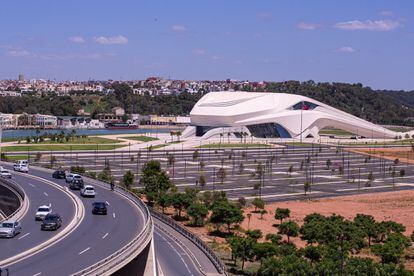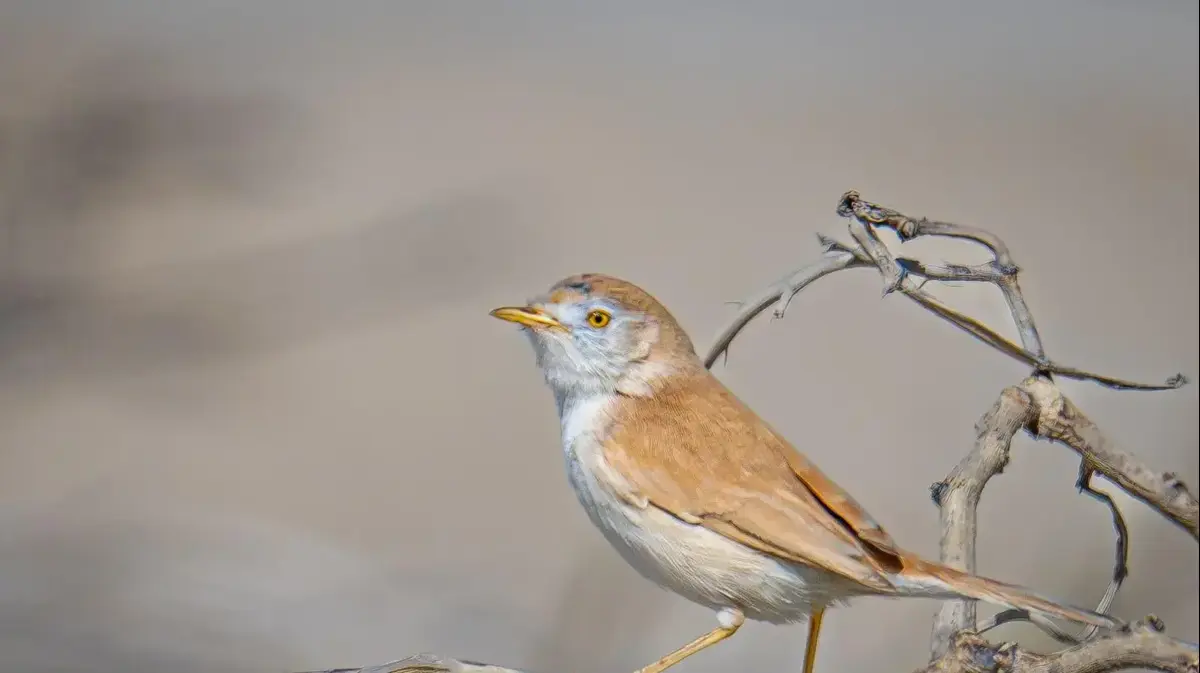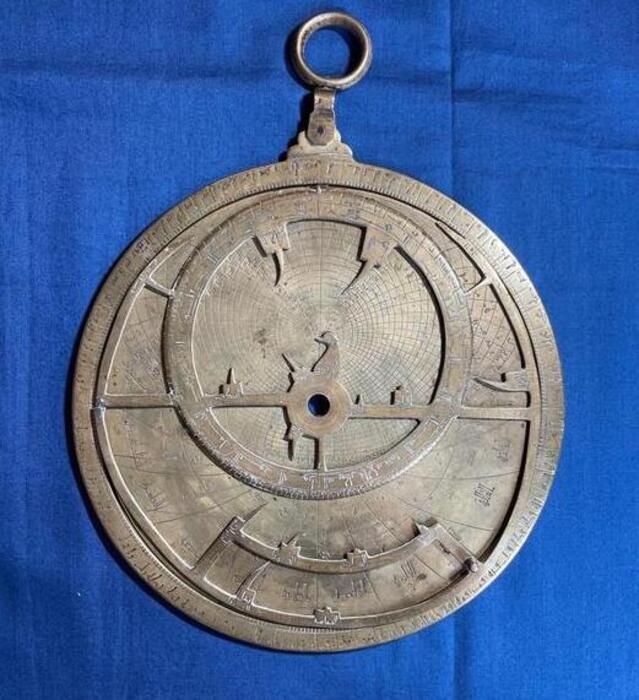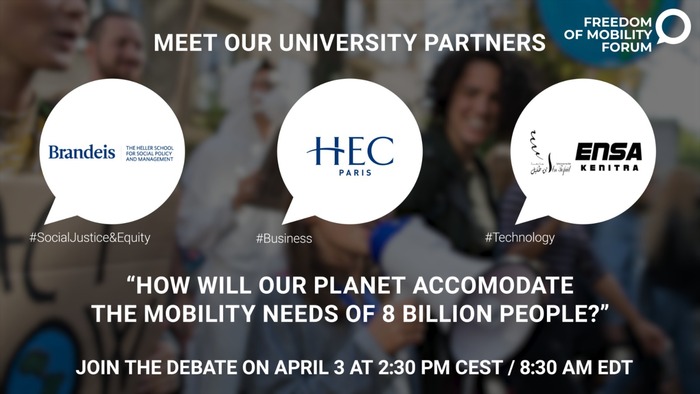A boatman crosses the Bou Regreg river without tourists, between the city of Sale and the Moroccan capital, Rabat.FADEL SENNA / AFP via Getty Images
Dozens of Indian, Pakistani and Moroccan welders toil night and day at the entrance to Rabat, along the Buregreb River, to build the tallest skyscraper in Africa, the so-called Mohamed VI Tower, named after the King of Morocco.
The mass will measure 250 meters and can be seen from 50 kilometers around, something unprecedented in the Maghreb.
The first third will be devoted to offices, the second to a luxury hotel and the third to homes.
More information
A Spanish architect signs the tallest skyscraper in Africa
The tower is already a symbol of the strength of a State that loves great symbols. The works began in November 2018 and its expected delivery date is early 2023. The project promoter is the Bank of Africa, with Moroccan capital, and the approximate cost is 300 million euros. Spanish architect Rafael de la Hoz, 66, is responsible for the design together with his Moroccan colleague Hakim Benjelloun. De la Hoz explains from Madrid: “I know that many people had doubts about whether it was going to be done, but there it is. It is a formidable investment whose objective is to develop that area of the Buregreb river, the connection between the cities of Rabat and Salé ”.
In front of the tower stands the Grand Theater of Rabat, like a huge white whale beached on the other bank of the Buregreb.
It was designed by the team of architect Zaha Hahid, the first woman to win the Pritzker Prize.
Its estimated cost is 200 million euros.
It is practically finished, but not inaugurated.
Some critical voices, such as the journalist Alí Amar, director of the digital site
LeDesk
,
cross
out these works as pharaonic “white elephants”.
"What's the point of building that skyscraper in Rabat, where there are no companies?" He asks.
“What are they going to do, put the entire Moroccan administration in there?
And as for the theater: here there is no cultural activity to fill it with content.
It is a waste of money ”.
Great Theater of Rabat, designed by the team of architect Zaha Hahid.Jesús Churrete
Morocco has become used to executing projects that had never been undertaken in the Maghreb.
In 2007 he opened the port of Tangier Med and broke the monopoly of Algeciras in the Strait crossing.
That same year, the Renault-Nissan consortium installed a mega-factory in the port's free zone that generated 6,000 direct jobs and another 30,000 indirect ones;
In 2016, the Noor solar thermal mega-plant started operating in the desert;
in 2018 the first high-speed train in North Africa, the fastest on the continent, built by the French group Alstom;
in 2019 it expanded the northern port with the Tanger Med II terminal.
And the following year the port was already overtaking Algeciras in container traffic.
Now, the big projects committed are the construction of a port in the Saharawi city of Dakhla and another in Nador.
More information
Morocco wants to industrialize its economy
“Actually,” notes an economist requesting anonymity, “the two landmarks for this country were Tanger Med and the Renault-Nissan factory.
Because Dakhla will be too far from everything.
And Nador has hardly any connections to the rest of the country.
The solar thermal power plant has been revealed as a management fiasco.
But the great success of Morocco is not even Tanger Med, because although Rabat is given a lot of hype, it must be taken into account that 80% of the trade enters through Casablanca.
The great success is its relationship with the European Union ”.
Morocco likes to measure itself against Europe.
And sometimes it is favored.
The World Health Organization congratulated Rabat in March for being among the top ten countries that have overcome the challenge of vaccination against Covid-19.
Morocco
you have injected more than 90% of the total dose
that have reached Africa, according to the health authorities in April.
Another reason to feed national pride.
However, what is allowing his diplomacy to be safe and defiant is the accolade that former US President Donald Trump gave the country by recognizing its sovereignty over Western Sahara in December while Rabat embarked on diplomatic relations with Israel.
That has caused Rabat to pressure the Spanish government to support Trump.
And it has extended the pressure towards Germany, aware of the Germanic leadership in the European institutions.
More information
Morocco tenses its pulse with Germany over Western Sahara
Morocco knows that the EU is its main partner, the place where 53.1% of its imports come from and where it destines 66.7% of everything it exports. And within the EU, Spain stands out, unseating France more than five years ago as the leading provider of goods and services. At the same time, Spain was the first country to which Morocco directs its exports (24.61% of the total), followed by France. But Rabat also knows everything that the European Union - and especially Spain and France - need to combat irregular emigration and Islamist terrorism.
The same day that Trump announced his historic accolade, Morocco suspended until further notice the bilateral summit or High Level Meeting (RAN) that it planned to hold with Spain in Rabat last March.
Shortly after, in April, the Moroccan secret services scored a great goal against those of Spain and Algeria, when they discovered and leaked to the weekly
Jeune Afrique
that the general secretary of the Polisario Front, Brahim Gali, had been admitted to a hospital in Logroño with False identity.
Those responsible for Foreign Affairs demanded explanations from Spain.
In this context of national pride, the Moroccan writer settled in France
Tahar Ben Jelloun wrote on May 3 on the
Le360
website
: “Spain's desire to join Algeria is to prevent Morocco from becoming an emerging power that could embarrass it.
Morocco's achievements in recent years, especially the success of the Tanger-Med port and the project of the same kind in Dakhla, disturb a Spain that has underestimated Moroccan capabilities ”.
It is true that the Spanish Government does not intend to snub Algeria, the great protector of the Polisario Front, a country from which a third of the gas consumed by Spaniards comes and from which far fewer irregular migrants arrive than from Morocco: 1,465 Algerians without documentation arrived in Europe last year, according to the European agency Frontex, compared to the 11,998 Moroccans who hosted the Canary Islands in that period.
But the Spanish authorities do not usually express concern about Morocco's achievements. These successes also do not solve the great structural deficiencies of a country where a third of the population is illiterate; where the language of public schools and institutes is Arabic, but most university courses are taught in French. All this has an impact on school drop-outs and the poor training of workers.
Infrastructure achievements have not been able to alleviate poverty, which is prevalent in rural areas.
A misery that is reflected in tragedies like the one that happened in 2017 in a town in the Essaouira region, when 15 women were crushed to death in a stampede while waiting to receive a food basket from an Islamist association.
Nor has job insecurity disappeared, as was clear with the death of 28 people, most of them women, who drowned and electrocuted last February, in a Tangier basement registered as a garment workshop.
More information
Morocco relies on infrastructure to design the future
These achievements have not solved unemployment either, with unemployment affecting 45.3% of urban youth.
The 29-year-old national Taekwondo champion Anouar Boukharsa was filmed arriving by boat to Lanzarote in 2019. He threw his gold medal into the sea while saying: “It is useless”.
Millions of young people saw that image on the networks, before in the media.
The pandemic has left the press at the expense of subsidies.
The state pays the salary of most journalists.
But the newspaper
Ajbar al Yaum
, the most critical of the Royal Palace and the country's powerful, closed last March.
It alleged, among other reasons, that it did not receive public aid.
As for the capital, as an example of urban development, it still has a lot of room for improvement.
The Mohamed VI Tower, the Grand Theater of Rabat and other major works such as the new train station do not hide the reality of a city with hardly any recreational spaces for minors, with sidewalks full of cars, where it is impossible to walk, in front of the shortage of public and private parking, as is the case in most of the Maghreb.
A European observer notes:
“It is that we cannot equate Morocco with Spain, which has a GDP almost ten times higher.
But if you compare it with its surroundings, with Mauritania, Algeria, Tunisia… the balance is very favorable ”.
Some
Spanish economists familiar with the country often say that Morocco and Spain complement each other.
They claim that the pandemic demonstrated that short global value chains are safer than long-haul ones.
They explain that Tanger Med does not reduce traffic to Algeciras, but adds it to the Strait.
And that Spanish companies that export components for Renault cars made in Tangier also benefit from their sale.
And they add that the two electrical cables that link the two banks of the Strait since 1998 and 2007 contribute to establishing peace.
Peace seems solid, but political differences surface
every so often. In August 2018, Morocco closed the Beni Enzar commercial customs post, bordering Melilla, without notifying Spain. Two years later, Rabat began to curtail the contraband or portage from Ceuta. With the arrival of the pandemic, the two land borders were closed. And nobody knows what Morocco will do with them after the pandemic. Will it assume the social cost of leaving more than 3,000 porters without sustenance? Perhaps not even Morocco knows the answer. Although in the long term, Rabat seems to have a clear objective regarding what it considers to be the “occupied prisons” of Ceuta and Melilla.
Despite these latent tensions, business continues to bring the two shores closer together. Strawberry tempras are a good example. In 2003, the first Moroccans hired collectively in origin arrived in Huelva. And there were only five. Four years later they totaled 4,336. And this year they amount to 12,745 women. They work an average of three months and earn about 1,200 euros per month, seven times more than in Morocco, where most of them do not have social coverage.
The Alsa bus company, perhaps the most successful of the more than 750 Spanish companies registered in the country, also presents another example of integration.
Since winning its first contest in 1998 in Marrakech, Alsa has spread to Casablanca, Agadir, Rabat, Marrakech and Tangier.
It has invested 250 million euros, has a fleet of 2,000 vehicles, has 7,000 employees and offers service to 13 million people, a third of the population.
The head of Alsa in Morocco, Alberto Pérez, 50, explains that the key to the smooth running was to enter with humility.
“We did not come to teach anyone.
I think that is a typical failure, not only of Spaniards ”.
The World Bank published its
Doing Business 2020
report in 2019
where it assesses the environment for doing business in 190 countries.
Morocco is ranked 53rd, only surpassed in Africa by Mauritius (13th) and Rwanda (38th).
And among the Arab nations, only the United Arab Emirates and Bahrain are ahead.
However, not everyone finds a good business climate.
The businessman Kepa Bárcena, 60, owns a small construction company that claims to have indirectly encountered the Royal Palace.
He maintains that the provincial authorities of Ualidía encouraged him in 2005 to invest in the area.
The bay of Ualidía, 200 kilometers from Marrakech, was presented in international media as the hidden paradise of Morocco.
Bárcena bought in 2005 a hectare classified as tourist in the urban plan of the previous year.
The land on which he intended to build a hotel is next to a palace that was the residence of Mohamed V, the current king's grandfather.
“The project obtained all the agreements,” says Bárcena, “but when the documentation had to be sent to Palacio, the urban agency refused to send the agreement.
They offered us neither alternatives nor compensation ”.
Bárcena did not throw in the towel.
In 2009, it bought another six hectares located one kilometer from the residence of Mohamed V, also in a tourist area.
He intended to build summer bungalows.
But the monarch promoted in 2010 a great sustainable development project in the lagoon with which he intends to decontaminate a place famous for its oysters.
Bárcena's new investment was also blocked.
The businessman assures that in 2019 he received a report from a senior Moroccan official where the paralysis was related to "Palace instructions."
Finally, Bárcena visited last year together with the Spanish ambassador, Ricardo Díez-Hochleitner, the Minister of Planning of the National Territory, Nuza Buchareb, who expressed his willingness to persevere in a solution.
Bárcena concludes: “The Palace promotes interesting development proposals.
But sometimes the authorities, perhaps out of fear of being wrong, decide to paralyze them ”.
The king is the one who has
the first and last word in the nation's strategic plans.
The one who gets the vaccine before anyone else to set an example and the one who in the midst of the pandemic promised to "generalize social coverage for all Moroccans in the next five years."
“Where is he going to get the money from?” Asks a European economist who wants to hide his name.
“They have a fiscal deficit of 7.5% of GDP.
I don't know how they could do it. "
The cardinal and archbishop of Rabat, the Spanish Cristóbal López Romero, praises the figure of the monarch: “For me it was admirable that as soon as the crisis began the king opened a fund for Covid-19.
It was the first to put 200 million euros.
And after him came others.
We can say that what is hunger, the people did not pass ”.
More information
The 20 years of Mohamed VI on the throne of Morocco
During the two decades of the reign of Mohamed VI the country grew at an average of 4% per year.
The pandemic reached Morocco after two years of drought.
And the economy, which had grown by 2.5% in 2019, entered a recession and contracted in 2020 to seven times its size.
For this year, in which the rains have returned, the IMF forecasts a growth of 4.5%, although the central bank Bank Al-Maghrib, estimates that it will be 5.3%.
In any case, it will be a figure lower than the 6% growth that the international entity predicts as the average in the world.
Morocco has so far managed to wade through the pandemic without causing a social outbreak, except for some demonstrations in Fnideq that called for the reopening of borders with Ceuta.
But the silent outbreak of 23,000 irregular migrants arrived in the Canary Islands, of which more than half were Moroccans.
To deal with the crisis, the State relied on aid from the European Union, estimated at 450 million euros to respond to immediate needs.
It also resorted to a $ 3 billion loan (2.471 million euros) offered by the International Monetary Fund and other loans from international banks worth € 677 million.
It was also financed in the foreign market through two debt issues totaling almost 3,500 million euros.
All this has allowed the State to maintain its foreign exchange reserves, but its global public debt soared in 2020 to 92% of GDP, almost 12 percentage points more than the previous year.
"We have avoided the crash," says Ali Amar.
“But we have only put the problem off for a year or two.
Now we are very indebted ”.
Moroccans Residing Abroad (MRE), lifelong migrants, also came to the rescue of the country, perhaps unknowingly, by sending their families 5% more money than before the pandemic, adding up with their foreign exchange 6% of GDP.
A member of Justice and Spirituality, an Islamist group that does not recognize Mohamed VI's spiritual hierarchy as a commander of believers, explains without revealing his name that state aid for the underprivileged has been "very limited" and "short-lived."
And he points out that his association, however, spared no means to help those most in need. "There has been a growth in begging, an increase in crime and only God knows what will come in the long term," he concludes.
to love
affirms that the state wants to remove Moroccans from Islamist solidarity networks.
And he adds that the best inheritance that Mohamed VI could leave is to offer coverage to the poor.
“The pandemic has shown us the way.
The most disadvantaged have seen an SMS reach their mobile phones and, without the need for a card, they were able to withdraw the equivalent of 200 euros a month from an ATM.
The State has known how to use the technology and the information it has on citizens, which is a lot ”.
Now, the great challenge of the regime, according to Amar, should be to improve social inequality.
"And for that, the relationship with Europe would have to be intensified," he concludes.
The thread with Europe has never been broken.
Rabat has tightened the rope but the collaboration continues to flow between the two shores.
For now
Strengths and weaknesses
Morocco imports more than 95% of the energy it consumes. That is one of the weakest points of its economy. And its biggest investment in renewables has not gotten off to a good start. The mega solar plant Noor, in the city of Ouarzazat, was presented in 2016 as one of the largest in the world. However, the Economic, Social and Environmental Council (EESC, for its acronym in French), an independent official institution, issued a report last year in which it asserted that the power station lost the equivalent of 75 million euros to the public coffers per year. anus.
In addition, Morocco is highly dependent on agriculture (14% of GDP and 30% of the population) and its economy leaves little room for competition, according to French consultancy Coface. An analyst requesting anonymity also highlights the need to increase the tax base. "All the reports say it," he says.
In terms of strengths, Coface highlights its geographical position, growing integration into the African market and the support of the international community. For its part, the EESC stresses the importance of phosphate reserves. And remember that the car industry surpassed phosphates in 2014 as the first export sector.









/cloudfront-eu-central-1.images.arcpublishing.com/prisa/MRCVFTDVBNHVFBKXS3VWGODRAE.jpg)